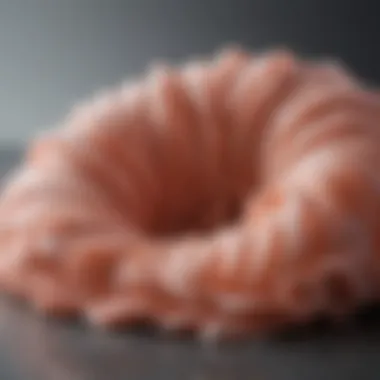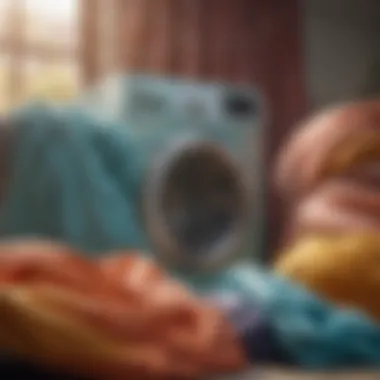The Subtle Benefits of Soft Laundry Detergent


Intro
When pondering the efficacy of laundry, many appear to overlook the pivotal role of soft laundry detergents. Tucked neatly in the aisles of grocery stores, these unassuming bottles hold secrets that extend far beyond cleanliness. They encapsulate the delicate dance of chemistry and comfort, designed to enhance the texture of your clothes while addressing a range of environmental concerns.
This article embarks on an exploration of soft laundry detergents, delving into their various compositions, benefits, and even their ecological ramifications. For housewives and homeowners dedicated to maintaining a refined living space and nurturing their most beloved fabrics, understanding the nuances of these products is essential.
Every sip of soft detergent carries a symphony of components that work harmoniously together. It's not just about getting rid of dirt or stains; it’s about preserving the integrity and feel of every stitch in your wardrobe. As we unravel the facets of this seemingly benign product, we aim to reveal the profound impact it has on lives beyond the laundry room.
Let’s kick off this journey with a glimpse into the trending styles that influence consumer choices and preferences in our modern world.
Understanding Soft Laundry Detergent
The topic of soft laundry detergent is critical for anyone looking to maintain not just the cleanliness of their clothes, but also their overall quality and durability. The gentle nature of soft detergents can make a substantial difference in how fabric behaves over time. They are engineered to protect fibers while still providing the cleansing power that is a necessity for modern life.
Factors of soft laundry detergent play an indispensable role in both household management and satisfaction with garment care. These detergents don’t just wash clothes; they soften them, ensuring that fabric maintains its look and feel, thereby extending its lifespan. This softening process contributes not only to the tactile experience but also aids in preserving colors and patterns that are so carefully chosen during purchase.
It's important to note that there’s a clear difference between standard laundry soaps and soft laundry detergents. This distinction matters when making choices in the laundry aisle. Understanding this can lead consumers to make informed decisions that reflect their needs, preferences, and ecological concerns. This brings us to the composition of soft laundry detergent.
Definition and Composition
Soft laundry detergent is specifically formulated to not just clean, but also soften fabrics without causing friction or damage during the washing process. The components of these detergents typically include surfactants, enzymes, and, importantly, softening agents like quaternary ammonium compounds.
- Surfactants help remove dirt and stains. They lower the surface tension of water, allowing it to better penetrate fabrics.
- Enzymes break down protein, starches, and grease, ensuring that stains don’t stand a chance against the wash cycle.
- Softening agents work by coating the fibers, providing a smoother texture and reducing the grip that one fabric has on another, resulting in less friction and wear.
In summary, the composition of soft laundry detergent is designed not just for cleanliness but for enhancing the fabric's inherent properties, offering a layered approach to garment care.
Types of Soft Laundry Detergents
Navigating the market of soft laundry detergents reveals a variety of types tailored for certain fabrics and washing conditions. A few commonly encountered forms include:
- Liquid Soft Detergents: These are versatile, dissolving easily even in cold water, making them ideal for quick washes and delicate fabrics.
- Powder Soft Detergents: Generally more economical and environmentally friendly, these work well in warm water and can offer hefty cleaning power for stubborn stains.
- Pods: Convenient and mess-free, pods combine both detergent and softening agents in a single, pre-measured dose but can be challenging for some recipes, depending on the washing machine.
- Eco-Friendly Brands: Growing in popularity, these formulations prioritize plant-based ingredients and biodegradable components, aimed at reducing environmental footprints.
Understanding these types enables consumers to choose a product that not only meets cleaning needs but also aligns with lifestyle values and fabric care requirements.
"Choosing the right type of soft laundry detergent can transform both everyday laundry into an effective and pleasant chore, and the longevity of your clothes has every bit to do with it."
The Science Behind Softening Agents
Choosing the right laundry detergent is much more than just picking a pleasant scent; understanding the science behind softening agents can make a real impact on the cleanliness and integrity of fabrics. Softening agents are crucial to the formulation of many laundry detergents, providing benefits that extend beyond mere softness. These ingredients are designed to ease friction between fabric fibers, helping to prevent damage and keep garments looking their best.
The importance of softening agents cannot be underestimated. Not only do they contribute to a cozy feel that many consumers desire, but they also help mitigate wear and tear caused by regular washing. When fabrics are subjected to the mechanical action in a washing machine, they experience stress that can lead to fraying or fading. Softening agents mitigate this effect, thus preserving the life and vibrant colors of the clothing.
Chemical Structure and Functionality
Softening agents typically belong to a class of compounds known as cationic surfactants. This might sound complicated, but it boils down to how these agents interact with water and fabric. These surfactants possess a positive charge, which allows them to bond with the negatively charged fibers of clothes. Once the detergent is in contact with wet fabrics, these cationic softeners latch onto the fibers, forming a thin film that reduces friction.
Their chemical structure usually includes long hydrocarbon chains, which play a significant role in their effectiveness. This structure provides the necessary hydrophobic (water-repellent) properties, allowing these agents to create a protective barrier around each fiber. As a result, fabrics remain soft while being less prone to tangling and breakage during washing.
The efficiency of these agents can be influenced by a variety of factors. Temperature, pH level, and the concentration of the softening agent all play roles in how well they perform their duties. It’s worth noting that an excessively high temperature or incorrect pH can diminish their beneficial properties.
How Softening Agents Work
Understanding how softening agents actually work requires a look at their interaction with the fabric and the laundering process. When introduced during the rinse cycle, these agents effectively envelop each fiber, providing a smoother surface that enhances the tactile experience of wearing the garment.
- The cationic surfactants not only make fabrics softer but also help repel dirt and reduce re-soiling. This means that clothes not only feel nicer but stay cleaner longer.
- Another important consideration is static cling, a common annoyance. By smoothing the fibers, softer fabrics create less friction, leading to a decrease in static charge accumulation.
- Furthermore, the addition of certain fragrances or natural ingredients, such as essential oils, can enhance the laundering experience, leaving behind a refreshing scent without overpowering synthetic odors that often linger.


"Softening agents redefine the laundry routine, transforming it into an experience that nurtures both fabric and the senses."
Benefits of Soft Laundry Detergent
The world of laundry care has often been preoccupied with the cleaning power of detergents, but it is high time we shift our focus to the subtle yet impactful benefits of soft laundry detergent. Beyond mere cleaning, these products offer a range of advantages that resonate deeply with individuals who value the longevity of their fabrics and the overall comfort in their home environment. When discussing the benefits of soft laundry detergent, we delve into three distinct yet interconnected aspects: fabric care and longevity, the sensory experience of softness, and the notable reduction of static cling. These benefits extend beyond personal preference, affecting both the usability of garments and their aesthetic appeal.
Fabric Care and Longevity
Soft laundry detergents excel not just at removing dirt and stains but also in preserving the integrity of fabrics. High-quality softeners are designed to penetrate the fibers of clothing, providing a protective layer that guards against wear and tear. This is particularly crucial for delicate fabrics like wool or silk, which can easily succumb to damage from harsh detergents. By using soft laundry detergents, you can significantly enhance the lifespan of your favorite garments.
- Preventing Fiber Damage: The gentle formulation of softeners prevents fiber fraying and fading, ensuring clothes maintain their original texture and color.
- Reducing Shrinkage: Many soft detergents also help minimize shrinkage, allowing clothes to retain their fitted shape and size over time.
- Preservation of Elasticity: For items like sportswear and undergarments that rely on elastic fibers, softeners maintain elasticity, providing that perfect fit with every wear.
In essence, investing in soft laundry detergent transforms washing from a mere chore into a proactive strategy for fabric preservation.
Sensory Experience of Softness
Softness plays a pivotal role in the overall sensory experience of wearing clothes. The tactile pleasure derived from wearing freshly washed garments cannot be understated. Here, soft laundry detergents shine bright. They not only elevate the quality of clothing but create a notable ambiance in the living space.
- Comfort against Skin: The softness achieved through these detergents makes garments gentler against the skin, greatly benefiting those with sensitivities.
- Enhanced Freshness: Alongside softness, many formulas incorporate fragrance components that not only soften but also infuse a delightful scent into fabrics, transforming the ordinary wash into an aromatic experience.
- A More Inviting Home: Fresh, soft linens contribute to an inviting atmosphere. Picture wrapping yourself in a fluffy towel or cuddling into a cozy blanket after a wash.
Ultimately, the sensory experience of soft laundry detergent goes beyond feel; it's about creating a sanctuary where comfort is prioritized.
Reduction of Static Cling
Static cling can be a nuisance that detracts from the overall satisfaction of freshly laundered clothes. Soft laundry detergents play an essential role in combating this pesky phenomenon.
- Anti-Static Properties: Many softeners contain anti-static agents that coat fibers. This coating helps to reduce the electrostatic charges that lead to cling, making clothes easier to wear and style.
- Simplifying Styling: For wearers, this translates into less frustration when dressing. You won't find clothes clinging to each other or creating those annoying little static shocks.
Moreover, less static means less lint and pilling, keeping garments looking polished and new.
"With soft laundry detergent, the challenge of static cling becomes a thing of the past, allowing you to focus on what truly matters: showcasing your personal style seamlessly."
Environmental Considerations
Understanding the environmental considerations surrounding soft laundry detergent is vital in today's eco-conscious world. With increasing awareness about our actions and their impacts on nature, choosing the right products can make a significant difference. Soft laundry detergents, often overlooked for their crucial role in fabric care, bring up essential discussions about sustainability and pollution. Educating consumers on these matters ensures a more responsible approach to laundry care.
Ecosystem Impact of Detergents
Laundry detergents have come a long way, but their impact on the ecosystem is still quite profound. The chemicals in conventional detergents can seep into waterways, affecting aquatic life and disrupting ecosystems. For example, phosphates, commonly found in many detergent formulas, can lead to algal blooms in lakes and rivers, creating dead zones where fish and other organisms cannot survive.
Water pollution from these products isn't just an ecological concern; it also poses risks to human health. Aquatic ecosystems are delicate, and introducing harsh chemicals can upset the balance, leading to long-term consequences for biodiversity.
Thus, being conscientious about the detergent you choose isn't merely a matter of personal preference—it's a matter of ecological responsibility. As more consumers seek to make a difference, brands are pressured to reformulate their products to lessen the environmental damage.
"Just because something cleans your clothes doesn't mean it won't dirty your water. Choosing wisely is part of being a responsible consumer."
Biodegradable Options Available
In light of the detrimental effects of traditional detergents, manufacturers are increasingly rolling out biodegradable options that cater to eco-savvy consumers. These products are designed to break down naturally, preventing them from lingering in the environment. Biodegradable detergents often utilize plant-based ingredients that are less harmful than their synthetic counterparts.
When you're scanning the laundry aisle, look for labels that indicate a product's biodegradable nature. Here are some questions to consider:
- What ingredients are used? Natural ingredients are often better for both your health and the environment.
- How do they break down in the environment? Research how quickly and effectively the product decomposes.
- Are there certifications? Look for third-party certifications that validate claims of eco-friendliness.
In summary, while soft laundry detergents offer undeniable fabric care benefits, their environmental implications demand attention. Striving to choose eco-friendly options not only enhances your laundry experience but also contributes to a healthier planet.
Selecting the Right Product


Choosing the right soft laundry detergent is crucial not only for maintaining the integrity of your fabrics but also for ensuring a pleasant laundry experience. In a market overflowing with options, it can become overwhelming for consumers to navigate product labels and ingredient lists. Thus, understanding the nuances involved in selecting the right detergent can make a significant difference.
Evaluating Ingredients and Labels
When perusing the shelves for soft laundry detergents, the first step lies in scrutinizing the ingredients and the labels. Many products flaunt catchy titles and vibrant packaging, but the true value is often hidden in fine print. You want to look for ingredients that are gentle on fabrics yet effective in cleaning. Key elements to keep an eye out for include:
- Cationic Surfactants: These are essential for softening fabrics and often make up the bulk of softening agents. They help to reduce static cling.
- Enzymes: Present in some detergents, these help break down stains and can enhance overall cleaning performance.
- Fragrance: While scents can create a pleasant experience, it’s best to choose products with natural fragrances if you or your family have sensitivities.
When evaluating the labels, also check for certifications. Products labeled as biodegradable or those with eco-friendly certifications can offer some peace of mind regarding the environmental impact of your choices.
"A wise consumer reads between the lines, making informed choices that go beyond marketing slogans."
Personal Preferences and Fabric Compatibility
Next, consider your specific needs or preferences. Not all fabrics are created equal, and what works for one may not be suitable for another. Here are some points to factor into your decision-making process:
- Fabric Types: Cotton, wool, synthetic blends, or delicate fabrics—each one may have different requirements. For example, silk may demand gentler formulas, while towels can tolerate a more robust detergent.
- Sensitivity: Does anyone in your household have sensitive skin? Opt for hypoallergenic products that are designed to minimize irritation. This not only affects the comfort of your clothes but the well-being of your loved ones.
- Fragrance Preferences: Each of us has a unique nose. Whereas some prefer a fresh scent, others might want something lighter or even unscented. Experimenting with different products in small quantities can lead to discovering the perfect match for your laundry.
By pondering these personal considerations and matching them with the fabric types in your home, you can confidently select a soft laundry detergent that meets both your expectations and your household’s diverse needs. This thoughtful approach not only enhances your laundry results but also contributes to fabric longevity.
Application Techniques for Optimal Results
The choice of laundry detergent can be a game-changer, but how you apply it can make or break the laundering experience. The right application techniques help ensure that soft laundry detergents truly deliver their promised benefits. These techniques not only enhance the effectiveness of the softening agents but also contribute to overall fabric care, offering both aesthetic and functional advantages.
Dosage Recommendations
Getting the dosage right is crucial. Too much detergent can lead to residue build-up, making fabrics feel rough rather than soft. On the flip side, using too little may not effectively soften your clothes. When it comes to soft laundry detergents, a general guideline is to follow the manufacturer’s instructions on the packaging. Usually, you’ll find that:
- For standard-sized loads, one capful (approximately 1 ounce) is often sufficient.
- Larger loads might require an additional half-ounce, but tread carefully—excess can cause a slew of problems.
It's not just about quantity; the type of laundry matters too. If you’re dealing with heavier fabrics like towels or bedding, a slight increase in dosage can be justified. However, for lightweight clothing, stick to less.
"More is not always better; in the case of soft laundry detergent, less could be more efficient and cost-effective!"
Another thing to consider is the water hardness in your area. Softer water usually requires less detergent than hard water to achieve optimal results. If you're unsure, consult local guidelines or do a simple water test.
Timing of Softener Usage
The timing of when to add your soft laundry detergent can significantly influence its effectiveness. Ideally, softer benefits should be maximized by integrating the softener at the right moment during the wash cycle.
- During the Wash Cycle: Some soft laundry detergents can be added at the beginning of the wash, effectively allowing the ingredients to infuse into the fabric from the get-go. This method works well with machines that thoroughly mix the detergent with the water.
- In the Rinse Cycle: However, many users find that adding it during the rinse cycle produces superior results. By doing so, the softening agents cling to the fabric without interruption from the washing action, meaning they can do their job without being washed away too soon.
- Specialized Appliances: If your washer has a dedicated compartment, rely on it! These compartments are specifically designed to release the softener at the appropriate time, providing maximum benefit.
The key takeaway is that understanding the function of timing can significantly enhance the outcome of your laundry endeavours. When employed correctly, these techniques not only ensure the longevity of your fabrics but also transform the laundry experience into something distinctly enjoyable.
Innovations in Laundry Care
In recent times, laundry care has taken a significant leap forward, moving beyond just cleaning to becoming a holistic experience tailored to both functionality and user convenience. Innovations are reshaping the way we approach the oft-overlooked task of laundry, emphasizing not only the effectiveness of cleaning solutions but also considerations surrounding ecological impact and user-friendly technology. With rising environmental concerns and the continuous advancement in smart appliances, these innovations are positioned as pivotal in adapting our laundry habits to modern-day realities.
Sustainable Alternatives to Traditional Detergents
As eco-conscious consumers look to lessen their environmental footprint, the spotlight shines bright on sustainable alternatives to traditional laundry detergents. Many brands are now offering formulations that eschew harsh chemicals, focusing instead on plant-based ingredients that are both effective and gentle on the ecosystem.
These alternatives, such as those made by brands like Ecover, Seventh Generation, and Method, are designed to break down easily, minimizing harm to aquatic life and soil quality. Importantly, many of these products are also packaged in recyclable materials, aligning with consumers’ desires for a zero-waste lifestyle.
Here's a breakdown of some benefits of resorting to sustainable alternatives:


- Biodegradability: These detergents break down naturally, ensuring they don't persist in the environment long after use.
- Reduced Toxicity: They contain fewer synthetic ingredients, which translates to less risk for families, pets, and wildlife.
- Resource Conservation: Many brands prioritize ethical sourcing of ingredients, promoting sustainable agricultural practices.
"Making a small switch from traditional to eco-friendly products can seemingly be a drop in the bucket, but collectively, it creates a wave of positive change in our environment."
Smart Laundry Appliances
With the advent of technology, smart laundry appliances have made their mark, transforming the way we approach laundry. These gadgets are engineered to augment the user experience, integrating convenience with efficiency.
For instance, modern washing machines and dryers now offer Wi-Fi connectivity, allowing users to control their laundry remotely via smartphones. This means no more waiting around for a load to finish; you can monitor progress, adjust settings, or even receive alerts when a cycle is complete right from your pocket.
Some notable features include:
- Automated Dispensing: Advanced machines can automatically dispense the right amount of detergent based on load size and fabric type, reducing waste and ensuring optimum cleaning performance.
- Adaptive Washing: Certain smart washers adjust water levels, temperatures, and cycle durations by analyzing load characteristics, which leads to better fabric care.
- Integration with Other Smart Home Systems: These appliances can connect with systems like Google Home or Amazon Alexa, meaning you can just ask your voice assistant to remind you when to switch loads.
As these innovations continue to develop, not only do they enhance efficiency in laundry care, but they also open the door for a more sustainable and conscious lifestyle. From using eco-friendly products to integrating technology into your wash routine, embracing these advancements can lead to a cleaner home and a cleaner planet.
Consumer Perspectives
Understanding the mindset of consumers is fundamental when discussing soft laundry detergents. After all, these products are designed for those who seek comfort and efficacy in their laundry routines. Consumers frequently make decisions based on a myriad of factors, such as effectiveness, safety, cost, and environmental impact. This section not only sheds light on the consumers' views but also explores the significance of customer reviews and the emerging trends in consumer preferences.
Importance of Customer Reviews
Customer reviews hold a powerful sway over the choices of prospective buyers. When someone is in a laundry aisle, scanning through various types of soft detergents, the thoughts running through their mind often revolve around previous user experiences. Each review becomes a small puzzle piece in the larger picture of a product’s reputation.
- Trust Factor: Positive reviews can build immense trust. A product’s rating can serve as a quick gauge to establish credibility.
- Product Insights: Reviews often highlight specific benefits that may not be mentioned on the packaging. For instance, a consumer may note how a particular soft detergent removed stubborn stains while simultaneously softening fabrics.
- Contrasting Opinions: It's also crucial to consider negative reviews. They can reveal potential pitfalls of a product and guide consumers away from options that may not meet their expectations.
In today’s digital age, platforms like Reddit and Facebook play a pivotal role in shaping public opinion. Participating in these online discussions can help consumers feel more confident in their choices regarding household products.
Trends in Consumer Preferences
As the landscape of consumerism evolves, so do the preferences of savvy shoppers. When it comes to soft laundry detergents, a few key trends have emerged:
- Eco-Friendly Products: With a growing awareness of environmental issues, many consumers are making a switch to biodegradable soft detergents. They're looking for options that offer gentle care for their clothes while also safeguarding the planet.
- Multi-Functional Formulae: Consumers are attracted to products that combine benefits. Soft detergents that also boast stain-fighting capabilities or are allergen-free are becoming more popular.
- Scent Choices: The olfactory experience is significant when selecting a detergent. People want their laundry to smell fresh, leading to a burgeoning demand for scents that are both pleasant and lasting.
These preferences highlight a shift not only towards sustainability but also an increasing appreciation for quality products that meet multiple needs.
"Consumer choices echo their values, with more people weighing the benefits of soft laundry detergents not just for their fabrics, but for the world they inhabit."
In summary, consumers are not merely passive buyers; they are informed individuals who seek products that align with their personal values and lifestyle choices. As their expectations evolve, the market for soft laundry detergents will undoubtedly be influenced by the voices of consumers, shaping the future of laundry care.
Ending
The significance of understanding soft laundry detergents cannot be overstated. These products hold a unique position in garment care, influencing not just the tactile experience of fabrics but also their longevity and overall appearance. Soft laundry detergents contribute to a more pleasant laundry routine and create an inviting atmosphere in the home.
One of the crucial elements that emerge from our exploration is the delicate balance between performance and environmental responsibility. With consumers increasingly leaning towards eco-friendly options, the developments in this sector showcase the industry's responsiveness to a conscientious clientele. As such, selecting the right detergent becomes a matter of aligning with personal values while ensuring optimal care for beloved fabrics.
Ultimately, soft laundry detergents offer a realm of advantages that can elevate everyday experiences, making them an essential item in modern households. Whether it’s the soothing softness of a freshly laundered towel or the absence of static cling from clothes, these products fulfill everyday needs in profound ways.
Summarizing Key Points
Throughout this article, we have touched on several pivotal aspects of soft laundry detergents:
- Definition and Types: Soft laundry detergents vary widely, featuring different compositions tailored for various fabric needs.
- Chemical Foundations: The chemical properties that make softening agents effective show us that science plays a crucial role in laundry care.
- Tangible Benefits: Enhanced fabric care, sensory experiences, and reduced static cling illustrate how these products significantly benefit consumers.
- Environmental Performance: The impact on ecosystems and the emergence of biodegradable options highlight the evolving nature of these products, reflecting a growing awareness of sustainability.
- User Preferences: Insights from consumer perspectives reveal trends that shed light on how individuals select products based on various influences.
This encapsulates the multifaceted nature of soft laundry detergents, reminding us that they do more than just clean—they enrich our daily interactions with clothing and textiles.
Future of Soft Laundry Detergents
Looking ahead, the future of soft laundry detergents appears promising and imaginative. With consumer preferences shifting towards more sustainable choices, many brands are innovating to meet these expectations.
- Eco-Friendly Formulations: Expect to see an increase in natural ingredients that not only protect fabrics but also minimize environmental footprint.
- Technological Advances: The integration of smart appliances is likely to evolve, facilitating precise detergent dosages and smarter laundry cycles that enhance fabric care.
- Customization and Personalization: A trend toward customizable laundry products is emerging as consumers seek specific attributes aligned with their lifestyle and family needs.
With these advancements on the horizon, soft laundry detergents will not only maintain their status as household essentials but potentially become champions of sustainability and fabric ethos.















